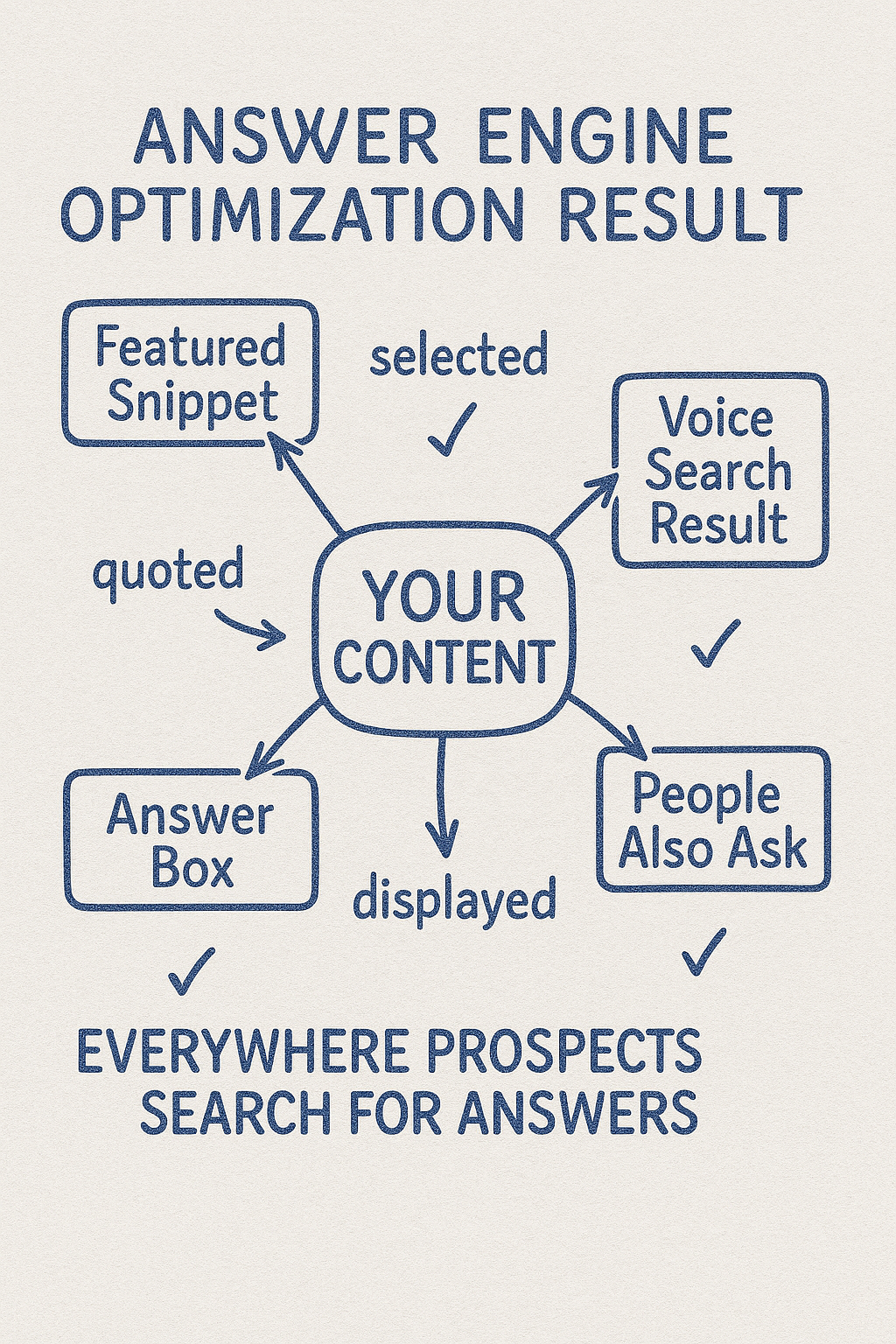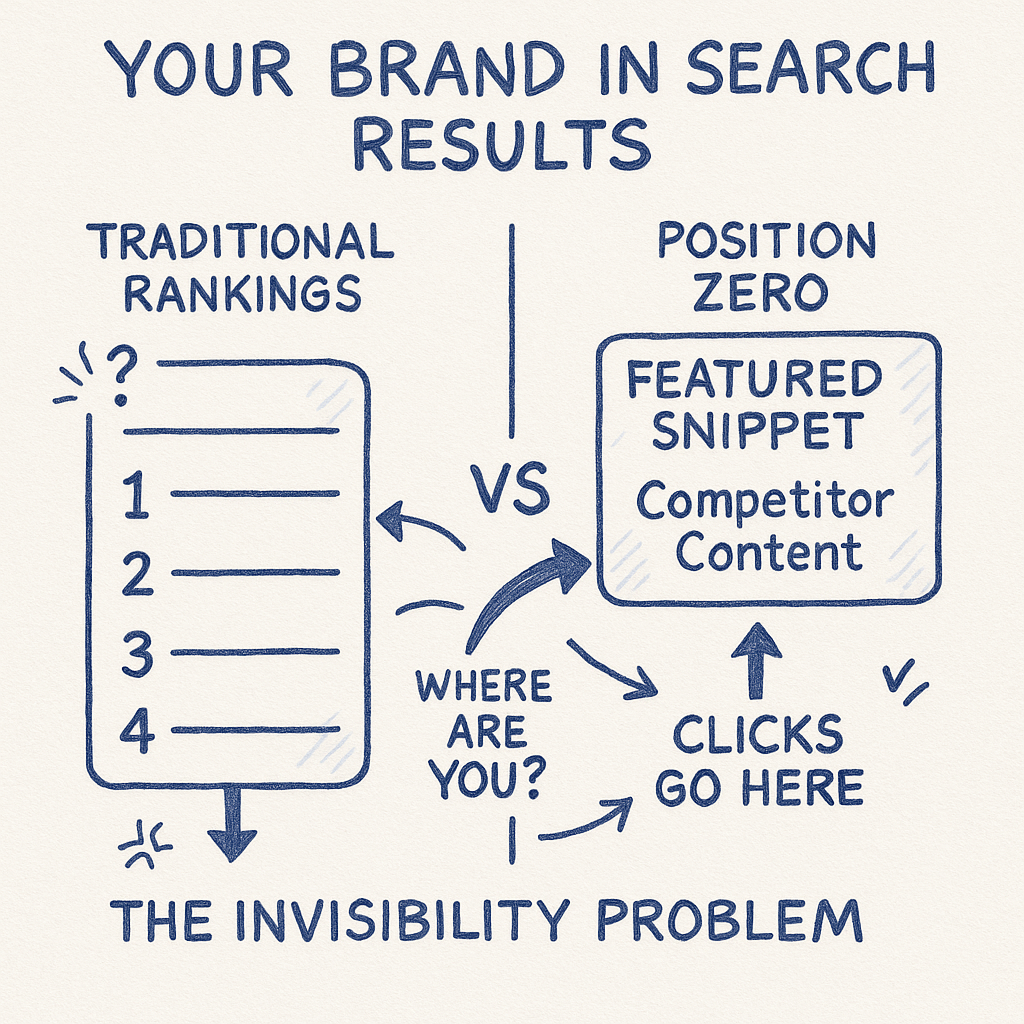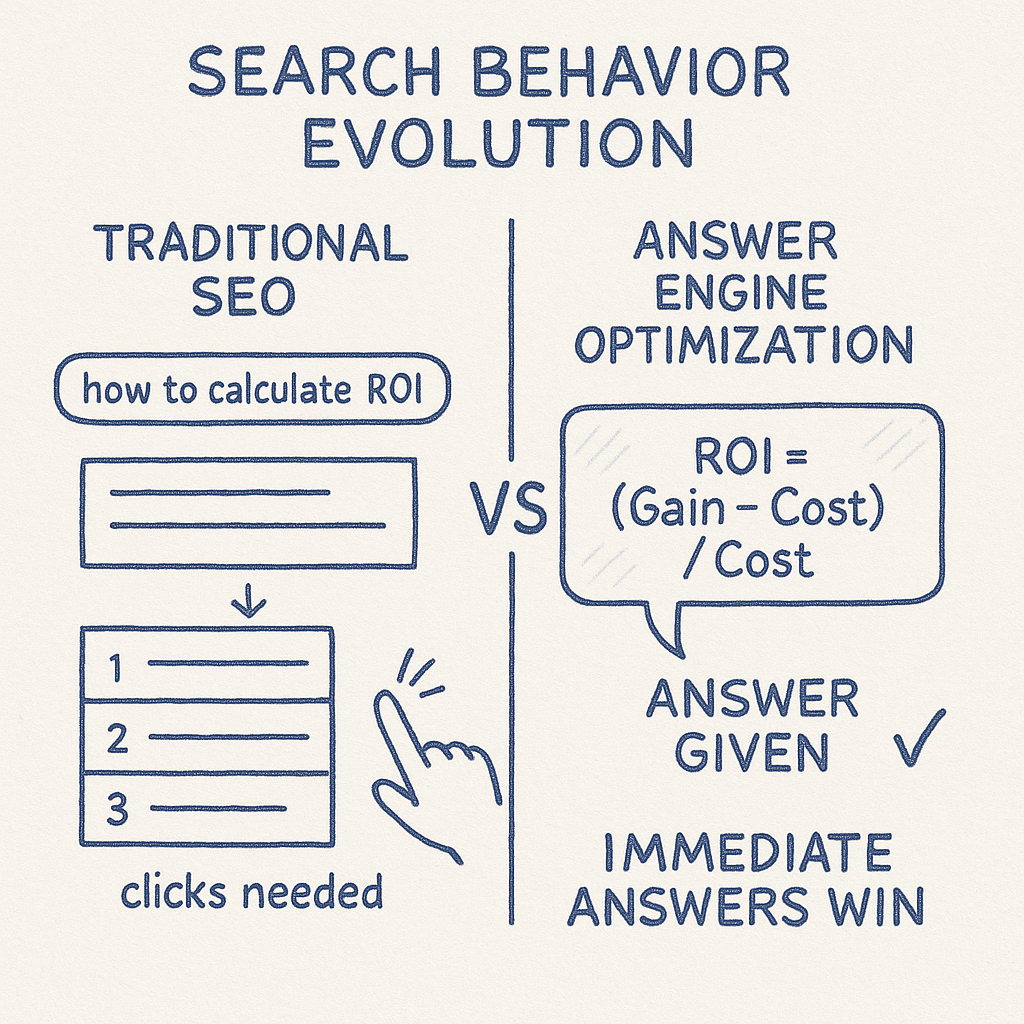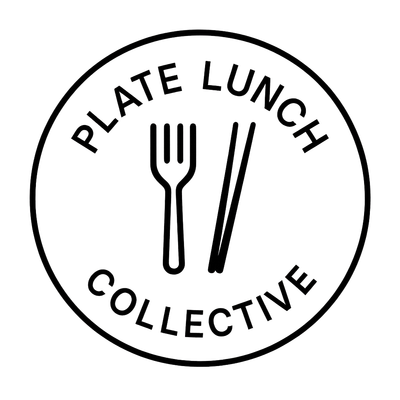Answer Engine Optimization for Hawaii Companies

Your competitors are already dominating Google’s featured snippets and AI summaries. When someone searches for a solution, their brand is the answer, not yours.
In Hawai‘i, this matters more than anywhere else. A visitor asks Google, “best poke near Waikīkī.” A parent in Pearl City asks Siri, “ABA therapy near me.” A contractor on Maui searches, “how to calculate project ROI.” If your content is not structured for answer capture, you are invisible.
Featured snippets receive up to 35% of clicks when they appear. AI summaries, voice assistants, and knowledge panels deliver answers without a click at all. That is traffic and brand impressions your competitors capture while your content sits buried below the fold.
What Answer Engine Optimization Really Means
Answer engine optimization is the practice of structuring your content to capture Google's featured snippets, knowledge panels, People Also Ask boxes, voice search results and AI summaries. Traditional SEO focuses on ranking in the ten blue links. Answer engine optimization services make your content appear as the direct answer above all other results, while generative engine optimization trains AI systems to cite your expertise in entirely new contexts.
Traditional SEO tries to climb the “ten blue links.” AEO makes your business the answer itself.
Someone searches “how to create a marketing budget.” If you rank third, you are ignored. If you hold the snippet, you get the click, the authority, and the traffic.
For Hawai‘i businesses, this means beating OTAs, mainland chains, and review sites that siphon off local demand.

Companies approach this backward. They create comprehensive content and hope Google extracts something useful for answer boxes and summaries.
Real AEO strategy starts with understanding exactly what questions trigger featured snippets and AI summaries in your industry. Then you craft content to capture those positions. This requires comprehensive content strategy that aligns question research with broader business objectives.
The Traffic You're Missing
Everyone's chasing rankings. Featured snippets capture the clicks. AI summaries provided brand impressions, but result in fewer clicks.
Google processes over 8.5 billion searches daily. Featured snippets appear for up to 19% of all queries. That is more than one billion answer opportunities a day.
For Hawai‘i companies, every one of those searches is contested:
- OTAs own searches like “best hotels on Maui.”
- Yelp or TripAdvisor own “restaurants near Ala Moana.”
- Mainland providers dominate “ABA therapy cost” or “marketing consultant Honolulu.”
Without AEO, local businesses lose visibility in the exact moments when decisions are made.
Your competitors know this. You're debating whether featured snippets and AI summary summaries matter. They're capturing answer box after answer box in your industry.
Voice search makes this more critical. Someone asks Siri or Google Assistant a question. They get the featured snippet content read back as the answer. Your content isn't structured for snippet capture. You're invisible to the entire voice search audience.
We have tracked companies that properly implement AEO techniques. Within six months, many capture snippets for 40 to 60% of their target questions. The impact on visibility is immediate and measurable.
Why SEO Agencies Miss This
SEO strategies treat featured snippets and answer summaries as a nice bonus rather than a primary objective. They'll work on broad keywords and hope to accidentally capture some answer positions. This misses the entire point of how modern search behavior works.
People do not just search “digital marketing.” They ask:
- “How much should a Honolulu café spend on ads.”
- “What is the best project management software for a small construction firm on Kaua‘i.”
Generic content does not capture these questions. Hawai‘i businesses need a strategy designed for snippet and voice search dominance.
The agencies selling traditional SEO packages don't understand AEO optimization. It requires different content strategy, different keyword research, and different success metrics. It's easier to sell keyword rankings than answer capture strategies.
Real AEO strategy starts with question research, not keyword research. You need to identify the specific questions triggering featured snippets in your industry. Then create content that Google recognizes as the best answer.
How Google Actually Selects Featured Snippets and Assembles AI Answers
Google's featured snippet and answer summary algorithm prioritizes content that directly answers the search query with clear, extractable information. This creates specific optimization opportunities that most businesses ignore because they are still focused on the keywords and not the intent of the search.
Google favors content that provides clear, extractable answers:
- Concise definitions for “what is” queries
- Numbered lists for processes
- Tables for comparisons
- Direct answers in the first 40 to 60 words of a section
You can outrank higher authority websites by formatting your answers better. We have seen local startups capture snippets from Fortune 500 companies simply because their answers were structured for Google’s algorithm.
For Hawai‘i businesses, this levels the playing field. You do not need the biggest domain authority, you need the clearest answer.
What Actually Works in Hawai‘i
Most guides talk about adding FAQ sections or plugging in schema markup. Those tactics help, but they are only the surface. Real results in Hawai‘i come from understanding the way people here search, both visitors and residents, and then structuring content to answer those questions directly.

Mainland competitors and OTAs dominate generic queries like “best hotels” or “marketing budget template.” They rarely cover what matters most to island businesses. That leaves gaps that Hawai‘i companies can own:
- Tourism intent: Visitors ask “best snorkeling tour Big Island” or “things to do near Pearl Harbor”. If a local tour operator or attraction structures its content with the right tables, lists, and concise answers, it can capture those snippets ahead of national sites.
- Local services: Families search “ABA therapy Honolulu” or “Pearl City dentist hours”. These questions often have no strong featured answer. A clinic that builds direct, extractable responses can win both visibility and trust.
- Island-specific B2B: Contractors might ask “best project management software for a small firm on Kaua‘i”. A mainland article might explain project management software in general, but a Hawai‘i business that contextualizes tools for local conditions can secure the snippet.
Understanding search intent at this level makes all the difference. “Best poke near Waikīkī” demands a list with locations. “What is poke” works as a concise definition. The format has to match the intent, and in Hawai‘i those intents split between visitor discovery and resident decision-making.
Companies that see 200 to 300 percent increases in snippet capture are not recycling old blog posts. They are creating new content categories designed for answer engine visibility, tuned to how people actually search when they are on island.
Voice Search in Hawai‘i
Voice assistants source 41 percent of their answers from featured snippets. That means the same mechanics driving desktop snippets are also powering what people hear when they ask their phones a question.
In Hawai‘i, voice search is not just a convenience, it is often the primary way decisions get made:
- Tourism queries: Visitors walking through Waikīkī ask “coffee near Diamond Head” or “best shave ice in Kailua.” The phone reads back a snippet. If it is not your café or shop, the opportunity goes elsewhere.
- Local family decisions: Parents in Kapolei ask “ABA therapy near me” while driving. If your clinic has not structured content for snippet capture, the referral goes to a competitor that has.
- On-the-go services: Residents commuting on O‘ahu ask “is the HART rail open today”. A local answer structured for voice is far more valuable than a generic transit explainer from the mainland.
Voice queries are conversational. People speak in full questions, not keyword fragments. They use natural phrasing like “what is the best” or “how do I find.” AEO for voice in Hawai‘i means creating content that sounds natural when read aloud and is structured for direct extraction.
The companies preparing for this shift are already pulling ahead. Tour operators capturing “best snorkeling tour Big Island” in featured snippets are the same ones whose answers Siri and Google Assistant read aloud. Clinics surfacing for “speech therapy Honolulu” become the trusted name before a parent ever clicks.
Voice search patterns are still forming, but in Hawai‘i the stakes are clear. Whoever owns the spoken answer owns the customer.
Implementation in Hawai‘i That Matters
Answer Engine Optimization requires specific technical execution that goes beyond traditional on-page SEO. The way content is structured, how headings are organized, and where answers are placed all influence whether Google pulls your material into a snippet.

For Hawai‘i businesses, these technical choices are not abstract. They are what determine if a local tour company, café, or clinic can outmaneuver national competitors and OTAs.
- Direct answers first: Google typically extracts featured snippet content from the first 40 to 60 words of an answer section. A Big Island snorkel tour operator can secure the snippet for “best snorkeling tours near Kona” simply by front-loading a concise definition before any supporting details.
- Heading hierarchy: Using H2 tags for main questions and H3 for sub-questions signals answer hierarchy to Google. A Honolulu dental clinic that formats content around “What services do you provide” and “How much does a cleaning cost” makes it easier for Google to lift those answers into People Also Ask boxes.
- Structured formats: Tables for comparisons, numbered lists for processes, and bullet points for features consistently increase snippet capture probability. A Maui contractor who builds a table comparing project management software for small island firms is more likely to outrank mainland blogs for “best project management software Kaua‘i.”
Implementation in Hawai‘i is about more than checklists. It is about understanding which queries locals and visitors are asking, then building content that is both structurally sound and locally relevant. This combination is what moves your answers into the positions where decisions are actually made.
Measuring What Matters in Hawai‘i
Traditional SEO metrics like rankings and backlinks do not capture whether your business is winning in the answer economy. To evaluate Answer Engine Optimization properly, you need to measure featured snippet positions, knowledge panel appearances, and People Also Ask inclusions separately from standard rankings.
For Hawai‘i companies, this level of measurement does more than prove performance. It shows whether local businesses are keeping visibility on island or losing it to national publishers, OTAs, and mainland competitors.
- Snippet capture rate: Tracking the percentage of Hawai‘i-specific queries where your business holds the answer, from “best poke near Waikīkī” to “ABA therapy Honolulu.”
- Answer box impressions: Understanding how often your content surfaces for local intent searches like “coffee near Ala Moana” or “surfboard rentals Waikīkī.”
- Voice search visibility: Measuring whether Siri, Google Assistant, or Alexa is reading back your content when people ask spoken questions on the go.
We track featured snippet performance across hundreds of question keywords for our clients. The data shows consistent patterns: certain answer formats, lengths, and structures outperform others. In Hawai‘i, these measurements reveal how much opportunity is being captured by local businesses versus siphoned off by OTAs and mainland brands.
When you can see which answers you already own, which you are losing, and which have no strong coverage yet, you gain the roadmap to expand your presence. Measuring what matters is the only way to shift from guesswork to sustained visibility in Hawai‘i’s unique search environment.
The Reality in Hawai‘i
In every industry we analyze, a small group of companies capture the majority of featured snippets. Their competitors remain invisible in answer search. This is not random. It is strategic.
In Hawai‘i, the stakes are sharper. National publishers, OTAs, and mainland agencies are already claiming the answer boxes that guide visitor spending and local decision-making. A handful of local players have begun to compete, but the majority of island businesses are still absent from this space.
If you are not pursuing Answer Engine Optimization, you are effectively handing traffic, impressions, and customer trust to organizations outside Hawai‘i. Local visibility is not guaranteed simply because you operate here. It has to be won at the level of structured, answer-ready content.
Featured snippet competition is still less intense than traditional keyword competition. Most businesses do not understand systematic answer optimization. That means the window for establishing answer dominance in Hawai‘i remains open, but it is closing quickly as larger players move in.
Plate Lunch Collective: Hawai‘i’s Answer Engine Partner
Plate Lunch Collective is the only consultancy in Hawai‘i built specifically for the retrieval layer: featured snippets, answer engines, generative AI, and voice search.
- Local expertise: We understand the way kama‘āina and visitors phrase their questions differently.
- AI native: Our services go beyond SEO into Generative Engine Optimization and broader retrieval-layer marketing.
- Integrated strategy: AEO is not an add-on. We align it with your brand voice, content system, and business goals.
Your competitors are already fighting for Hawai‘i’s most valuable digital real estate. Do not let OTAs, review sites, and mainland brands own the answers your customers are asking.
Start Winning Hawai‘i’s Answer Boxes
Plate Lunch Collective helps Hawai‘i companies surface as the answer in Google, in AI systems, and in voice search.
Whether you are a restaurant in Honolulu, a healthcare clinic in Pearl City, a tour operator on Maui, or a contractor on Kaua‘i, your visibility depends on owning the answers people rely on to make decisions.
Contact us today to begin your Answer Engine Optimization strategy. Keep Hawai‘i searches connected to Hawai‘i businesses.
Frequently Asked Questions
What is Answer Engine Optimization?
Answer Engine Optimization (AEO) is the practice of structuring your content so Google and AI systems surface your business in featured snippets, knowledge panels, People Also Ask boxes, and voice search results. For Hawai‘i companies, this means capturing both visitor queries like “best poke near Waikīkī” and local intent searches such as “ABA therapy Honolulu.”
How is AEO different from SEO?
SEO helps you appear in search results. AEO makes your business the answer itself. In Hawai‘i, that means not just ranking on page one, but being the snippet Siri reads aloud when someone asks “coffee near Diamond Head.”
Who benefits in Hawai’?i?
Any business that relies on discovery benefits from AEO. Restaurants, tour operators, and attractions capture visitor demand. Healthcare clinics, ABA providers, and professional services connect with local families. Retailers and franchises compete more effectively with mainland chains.
How long does it take?
Most Hawai‘i clients begin capturing featured snippets within three to six months. Voice search visibility and AI summary citations often follow once the right answer formats are in place.
Do I still need SEO?
Yes. SEO builds discoverability, while AEO delivers authority at the point of decision. For Hawai‘i businesses, the two work together: SEO ensures you appear in results, AEO ensures you surface in the answer box where the customer actually stops searching.
Step above the silos.
Individual services solve problems. Our Fractional CMO service orchestrates the whole system.
Get Strategic Leadership